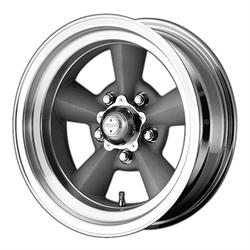American Racing Wheel and Tire Combo
The style of a car can really come together with the right wheel and tire combo. So once again, we turned to our friend and styling expert, Jeff K., for suggestions on what shoes the little coupe should run.
The Right Wheels
American Racing Wheels were a natural choice when we narrowed down to a mag look. They’re surprisingly affordable and have a genuinely vintage look.
Here’s what we chose:
American Racing VN3095565 TTO Series Wheel – 15x5, 5 on 4.5” – 2 qty
American Racing VN30958565 TTO Series Wheel – 15x8.5, 5 on 4.5” – 2 qty
These wheels have a machined outer lip and a dull grey center. After a little suggestion from Jeff, we made them look even more vintage by masking off the rim’s lip and spraying the spokes and centers with “Detail Grey” paint from Eastwood. It replicates the look of fresh cast magnesium, more like original mag wheels.
You can see the slight difference between the two. As Jeff K. says, “It’s a classy touch for low bucks.”
The Right Tires
We went back and forth on whether the coupe should run bias plys or radials tires. I’m all about “the look” and voted bias plys. I’ve been running bias plys on my ‘33 coupe for years and have never had an issue with them. And I drive the coupe A LOT. But George had strong opinions on running cheater slicks (which are radial) in the rear, and it’s a good idea to run either all radials or all bias plys.
So we settled on these radials for the front:
Coker 56047 Firestone F560 Blackwall Radial Tire-155R15, 4-5.5 In. Rim – 2 qty
A Good Dose of Vintage with Pie Crust Cheater Slicks
Named for the unique design around the outside edge of the sidewall, these tires have a truly vintage look from the 60’s hot rod scene.
We chose: 10” tread width, 29.5” diameter, 15” rim size.
These slicks have black walls and are built on new radial casings. The sidewalls have been smoothed and the manufacturer will add either two or four rain grooves, which are basically concentric grooves around the tire, for tread. We chose two, but if you want more traction during wet conditions, more grooves will help you.
There are several grooving options, including full grooved (straight and cross grooves), which resemble old dirt track tires. Also, shoulder grooves which are two straight grooves with shoulder notches.
I suspect that when we get caught in our first rain storm, the road won’t be the only thing that’s wet. We can always add more grooves with a tire grooving iron (p/n 445-251). Also, the American Wheels are affordable enough, we might just buy an extra set of rear wheels and a pair of 255/70R15 tires to have as backup for the slicks. What’s one more stack of tires in the garage, right?
The American Wheels came with caps, but we haven’t decided if we want to run them yet.



